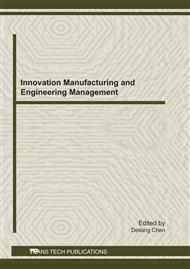[1]
Maccarthy B. L, Liu J.Addressing the gap in scheduling research: a review of optimization and heuristic methods in production scheduling. International Journal of Production Research, 31(1) ,(1993),pp.59-79.
DOI: 10.1080/00207549308956713
Google Scholar
[2]
Garretti M, Taisch M. Neural networks in production planning and control. Production Planning and Control,10, (1999),pp.324-339.
DOI: 10.1080/095372899233082
Google Scholar
[3]
Ding yong-sheng. Computing intelligent—theory, technology and application(Science Press,China 2004).
Google Scholar
[4]
Xuan guang-nan, Cheng run-wei. Genetic Algorithms and Engineering Design.(Science Press,China 2000).
Google Scholar
[5]
Zhang lian-zhen, Xu jin. The Research of DNA Computing Model by Operating on Plasmids. ComputerEngineering and Applications, 40(4),(2004),pp.51-52.
Google Scholar
[6]
Zhang hai-gang, Gu xing-sheng. Vehicle Scheduling Problem Based on DNA Evolutionary Algorithm.Journal of East China University of Science and Technology(Natural Science Edition), 32(12),(2006),pp.1463-1467.
Google Scholar
[7]
Niu qun, Gu xing-sheng. Flow Shop Scheduling Problems Based on DNA Evolutionary Algorithms. Journal of Shanghai University(Natural Science Edition), 10 (B10),(2004),pp.88-92.
Google Scholar
[8]
Liu min,Wu cheng. Intelligent Optimization ofthe manufacturing process scheduling algorithm and its application(National Defense Industry Press,China 2008).
Google Scholar
[9]
Wang wan-liang, Wu qi-di. Intelligent production scheduling algorithm and its application(Science Press,China 2007).
Google Scholar
[10]
Ding yongsheng, Shao shihuang, Ren lihong. DNA Computing and Soft Computing(Science Press,China 2002).
Google Scholar
[11]
Tao ji-li. Application and research of genetic algorithms based-on DNA computing(Doctoral dissertation of Zhejiang University,China 2007).
Google Scholar
[12]
Neuhauser C. and S. M. Krone. The Genealogy of Samples in Models with Selection. Genetics. 145(2),(1997),pp.519-534
DOI: 10.1093/genetics/145.2.519
Google Scholar


